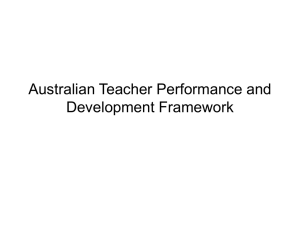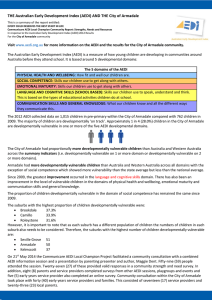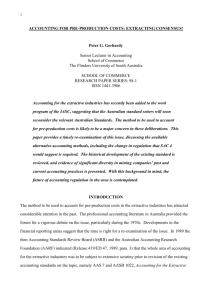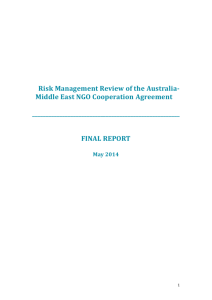Amy Farndale Mujema - University of South Australia
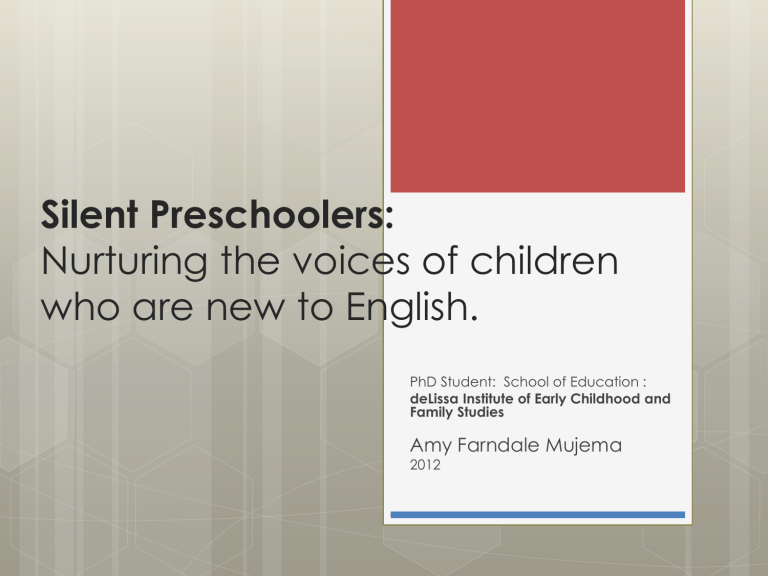
Silent Preschoolers:
Nurturing the voices of children who are new to English.
PhD Student: School of Education : deLissa Institute of Early Childhood and
Family Studies
Amy Farndale Mujema
2012
Australian context
According to the AEDI ( 2009, p.4
),
17.2% of all children in Australia speak a language other than English (LOTE) in the home.
There is a diversity of 279 languages , other than
English, spoken by Australian children ( AEDI 2011 ).
In South Australia, between 2010-11, 3,000 CALD
(culturally and linguistically diverse) children received preschool bilingual support ( DECS 2011, p.39
).
Worldwide, bilingualism is the norm.
Languages of Australian 4- to 5-year-old children
(McLeod 2011)
Greek and other
Vietnamese,
Arabic, Cantonese,
Italian, Spanish and
Somali
Samoan,
Vietnamese, and
Italian
Greek, African
Languages,
Portuguese,
Vietnamese, Spanish and other
Arabic, Cantonese,
Vietnamese, Italian,
Mandarin, Greek,
Hindi, Turkish,
Assyrian and Somali
Bengali, Cantonese,
Croatian, French, German,
Hindi, Italian,
Macedonian, Russian,
Tamil and Urdu
Cantonese
Figure 1. Main languages spoken by Australian children aged 4 to 5 years in each state and territory
Note: The darker shade indicates 16–26% of children aged 4- to 5- years in NSW and Victoria speak languages other than
English. The lighter shade indicates 4-9% and the lightest indicates 1–3% of children speak languages other than English in that state/territory.
Phases of English Language Learning
1. Pre-production
New to English
2 . Early Production
Becoming familiar with English
3. Speech Emergence
Becoming a confident user of English
4. Intermediate Speech
Demonstrated competency as a speaker of English
(Clarke 2009, Crosse 2007, Diaz-Rico 2008 and Tabors 2008)
Phase 1: Pre-production
New to English
May continue to speak 1 st language (as if understood)
‘dilingual discourse’.
May be socially isolated, overwhelmed, insecure
Is an observer
Often gives up speaking and enters a ‘silent period’
(lasting weeks to months)
Uses gestures / body language / facial expression
May rehearse words quietly to themselves
Receptive language (understanding) skills exceed expressive
(productive) language.
Phase 1: Pre-production
Gather information from parents.
Involve Parents.
Seek bilingual support and support the 1 st language.*
Learn some basic first language vocab. (audio record)
Learn correct pronunciation of name.
Offer bilingual books
Use gesture, facial expression, body language (culture?)
Adjust speech – slow, basic
Organise small groups and encourage peer interaction.*
Offer interactive activities
(Total Physical Response)
Welcome efforts, praise.
Use visuals, graphic organisers, realia (objects)
Revise Revisit Rehearse Recycle
Repeat Routines*
Speak with running commentary.
Provide input*
Encourage other modes of expression = arts, dance
Select appropriate levels of questioning – yes/no, point*
Introduce mainly tier 1 or 2 words*
Marion Blank’s Levels
Level 1: Matching
• Can you point to the ………..?
• Where is the …………?
• What is this?
Level 2: Relationships / classifying
• What does it do?
Level 3: Reorganising / Prediction
• What will happen next?
• Can you tell me the story?
Level 4: Explanations
• Why do you like that one?
Tiered words (Beck, McKeown & Kucan 2008)
Tier 1 - basic
• car
• big
Tier 2 – descriptive
(more in written text)
• gigantic
• opposite
Tier 3 – technical/specific
• condensation
• pupa
Phase 2: Early Production
Goes public with talk
Has telegraphic speech – 1-2 words to mean a sentence
Uses formulaic speech – Uses common phrases ‘I want…’
Hypothesises and tries out new formulations of sentences
Uses invented words to fill gaps in English sentences
For example ‘I want mm mm apple’ (‘to eat’ = mm mm)
May mispronounce words.
Phase 2: Early Production
Extend and expand sentences Encourage talk about concrete experiences
Pause – provide the child with an opportunity to respond
Continue to support the first language (transfer concepts)
Select appropriate levels of questioning
Focus on meaning rather than form
Encourage social interaction
Encourage singing songs (both languages) *
Select appropriate repetitive books. Repeat the same books but use in different ways
Focus on opportunities to talk *
Phase 3: Speech Emergence
Talks in sentences
Has a growing expressive vocabulary, initiates more freely.
Makes more grammatical mistakes and over-generalises rules.
Eg ‘I runned’. ‘He is a girl’.
Uses longer more complex utterances.
Make clarification checks – assesses own output (talk)
Phase 3: Speech Emergence
Refrain from rescuing the child and encourage their own speech attempts.
Promote collaborative learning.
Start introducing decontextualised language.
Employ higher levels of questionning such as categorisation and prediction.
Do not obviously correct children’s mistakes, but model, reformulate, rephrase, elaborate and expand..
Introduce Tier 2 words.
Phase 4: Intermediate Speech
Speaking with improved grammar
Expresses ideas.
Engages in conversations.
Explores complex ideas.
Can demonstrate leadership.
Is confident in exchanges.
Phase 4: Intermediate Speech
Focus on more abstract vocabulary
Introduce technical language.
(Increase Tier 2 and 3 words)
Use higher levels of questioning
(prediction, causal relationships)
Phases of English Language Learning
1
• Pre-production
• New to English
2
• .Early Production
• Becoming familiar with English
3
• Speech Emergence
• Becoming a confident user of English
4
• Intermediate Speech
• Demonstrated competency as a speaker of English
(Clarke 2009, Crosse 2007, Diaz-Rico 2008 and Tabors 2008)
Naturally every child’s experience is unique and these descriptions of the four phases aim to give a general understanding of
English language learning.
It takes 1-2 years to obtain BICS
(basic interpersonal communication skills)
It takes 5-8 years to obtain CALP
(cognitive academic language proficiency)
(Cummins 1985)
References:
AEDI 2009, A Snapshot of Early Childhood Development in Australia Australian Early Development Index (AEDI) National Report
2009 Re-issue, Australian Government Department of Education, Employment and Workplace Relations., Australia.
Clarke, P 2009, Supporting children learning English as a second language in the Early Years (birth to six years), Victorian
Curriculum and Assessment Authority, Victoria, Australia,
< http://www.vcaa.vic.edu.au/earlyyears/supporting_children_learning_esl.pdf> .
Crosse, K 2007, Introducing English as an additional language to young children : a practical handbook, 1st edn, Paul Chapman
Pub., London.
Díaz-Rico, LT 2008, A course for teaching English learners, Pearson/Allyn and Bacon, Boston.
Hirschler, J 1994, 'Preschool children's help to second language learners', The Journal of Educational Issues of Language Minority Students, vol.
14, pp. 227-240.
Krashen, S & Terrell, T 1983, The natural approach : language acquisition in the classroom, 1st edn, Pergamon Press ;Alemany
Press, Oxford [Oxfordshire] ;New York :San Francisco.
McLeod, S 2011, ‘Cultural and linguistic diversity in Australian 4- to 5-year-old children and their parents’, ACQuiring Knowledge in Speech, Language and Hearing Volume 13, Number 3 pp. 112-119
Priester, MM 2011, 'Using Song Lyrics in the Preschool ESL Classroom to Assist Students' English Vocabulary Retention and Use',
Curriculum and Instruction, Caldwell College.
Shao, Q 2005, 'Social context and language acquisition: a Chinese child learning English as his second language in naturalistic preschool settings', UMI.
Saville-Troike, M 1987, 'Dilingual Discourse: the negotiation of meaning without a common code.', Linguistics, vol. 25, pp. 81-106.
Swain, M 2005, 'The output hypothesis: Theory and research. ', in Hinkle, E (ed), Handbook of Research in second language
teaching and learning, Erlbaum, Mahwah, NJ, pp. 471-483.
Tabors, PO 2008, One child, two languages: a guide for early childhood educators of children learning English as a second
language, 2nd ed. edn, Paul H. Brookes Pub. Co, Baltimore, Md.








